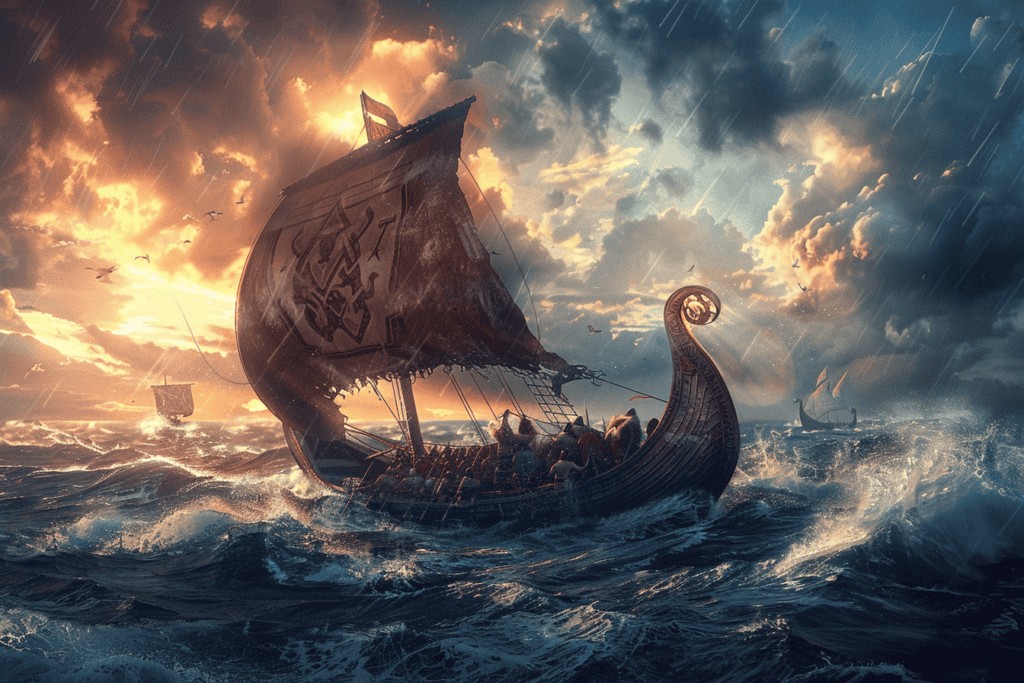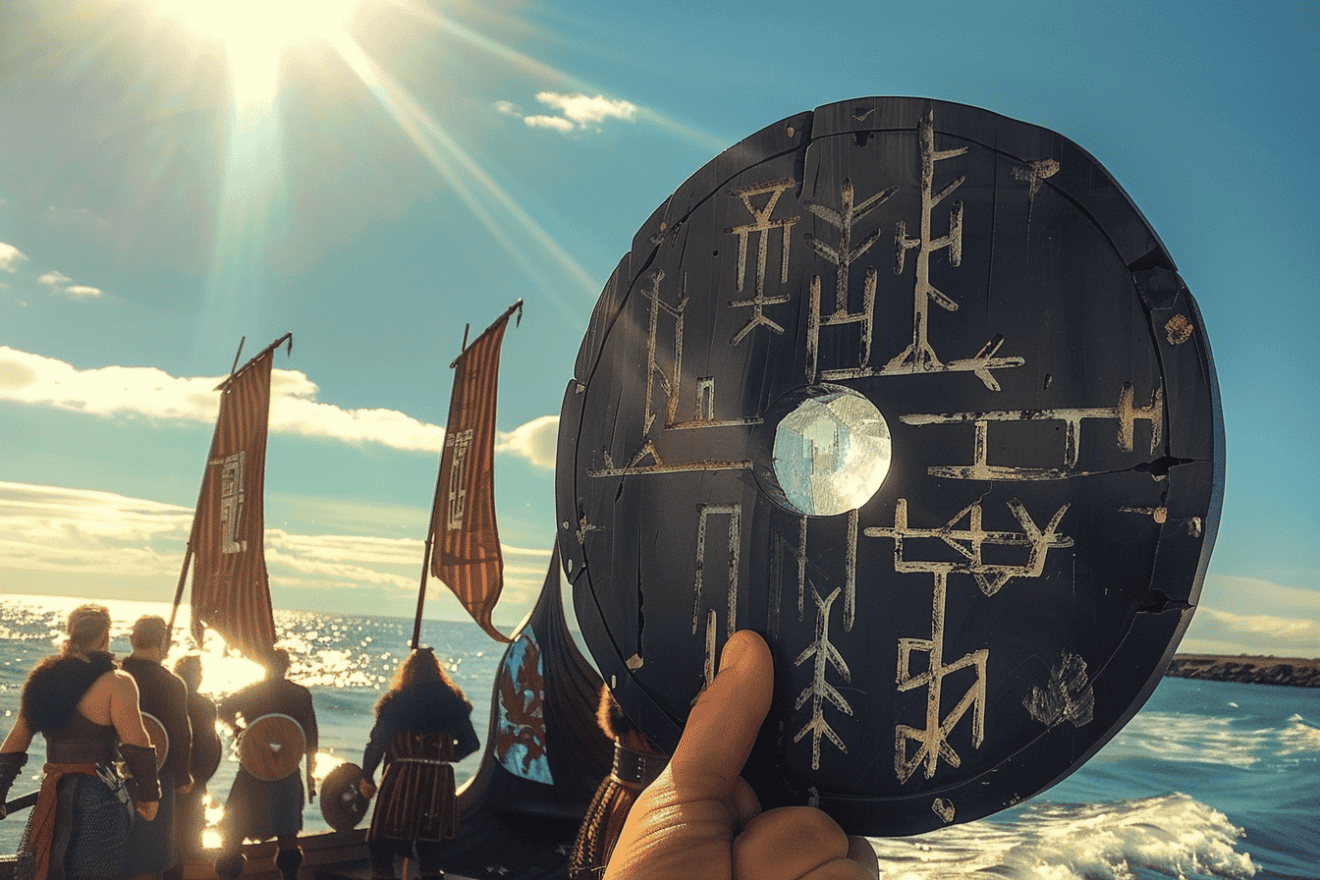Vikings are known for their seafaring skills and their ability to navigate through unknown waters. However, little is known about the methods they used to navigate.
Recent research has revealed that Vikings may have used an ancient crystal technology known as the Sun Stone to navigate their way to America.
The Sun Stone, also known as the Viking compass or solarsteinn, was a crystal that was said to have the ability to reveal the position of the sun even when it was hidden behind clouds or after sunset.
This technology was believed to have been used by the Vikings to navigate the North Atlantic Ocean, which was often shrouded in fog and mist.

Archaeological evidence of the Sun Stone is scarce, but in 2013, a crystal of Iceland spar was found among the wreckage of a British ship that sank in 1592.
This discovery raised the possibility that the sky-polarimetric navigation method might have been used even in the 16th century.
The use of the Sun Stone by the Vikings is still a topic of debate among scholars, but the evidence suggests that it was a crucial tool in their seafaring journeys to America.
The Role of Sunstones in Viking Voyages

The Vikings were known for their seafaring skills and their ability to navigate the treacherous waters of the North Atlantic.
One of the most intriguing aspects of Viking navigation is the use of sunstones, an ancient technology that allowed sailors to navigate by the position of the sun, even on cloudy days.
Sunstones were a type of navigational aid that used the properties of certain crystals to determine the position of the sun.
The most commonly used crystals were calcite, Iceland spar, cordierite, and tourmaline. These crystals were able to refract sunlight and create a double image of the sun, which could then be used to determine the direction of the sun, even when it was hidden behind clouds.
While there is no direct evidence of sunstones being used by Viking sailors, there is ample evidence to suggest that they were used as a navigational aid.
In fact, a crystal of Iceland spar was found amid the wreckage of a British ship that sank in 1592, suggesting that the sky-polarimetric navigation method might have been used even in the 16th century.
Using sunstones, Viking sailors were able to navigate their longboats from Scandinavia to Greenland, Iceland, and even Newfoundland, North America.
The journey from Scandinavia to Greenland was particularly treacherous, as it involved navigating through the icy waters of the North Atlantic. However, the Vikings were able to make the journey successfully, thanks in part to their use of sunstones.
Once the Vikings arrived in Greenland, they established settlements and began to explore the surrounding areas. They also continued their voyages to Iceland and North America, where they established a settlement at L’Anse aux Meadows in Newfoundland.
Ancient Crystal Technology

Crystals have long been associated with mystical properties and have been used for various purposes, including healing and divination.
The Vikings also believed in the power of crystals and used them for navigation. The crystal they used was known as the sunstone, and it was believed to have the ability to reveal the position of the sun even when it was hidden behind clouds or after sunset.
The sunstone was made of a type of calcite crystal that had the property of birefringence, which means that it could split a single beam of light into two beams that traveled at different speeds.
This property allowed the Vikings to determine the polarization of light, which they used to locate the position of the sun.
Navigating through the foggy, stormy, and cloudy meteorological conditions of the North Atlantic was a daunting task for Viking seafarers. However, they were able to navigate with the help of their ancient crystal technology.
According to a study published in the Royal Society Open Science journal, Danish archaeologist Thorkild Ramskou and physicist Gabor Horvath, along with a team of optics researchers, demonstrated that it was possible for the Vikings to navigate through fog using little more than a sunstone.
The Vikings would have rotated the sunstone until it matched up with the double-reflection of the sun, which would have allowed them to determine the position of the sun even when it was obscured by fog or clouds. This technique would have been especially useful during the winter months when the sun was low on the horizon and obscured by the clouds.
The Scientific Evidence

Gábor Horváth and his team of researchers from Eötvös Loránd University in Budapest, Hungary, conducted computer simulations and experimental tests to determine the accuracy of the Viking sunstone theory.
The team ran 1000 voyages between Norway and Greenland with varying cloudiness and found that the sunstone theory was indeed plausible. The results of their experiments were published in Science Magazine.
Stephen Harding from the University of Nottingham conducted planetarium experiments to test the sunstone theory.
He found that by using a sunstone, it was possible to determine the position of the sun even on cloudy days. This finding supports the theory that Vikings could have navigated using sunstones.
Historical Accounts and Reconstructions
Nordic sagas and medieval texts provide historical accounts of Viking navigation techniques. According to these accounts, Vikings used a variety of methods to navigate.
These methods included the position of the sun and stars, landmarks, and the behavior of animals and birds.
There is also evidence of Viking navigation tools, such as the sun dial and sundials found on Viking ships. These tools were used to determine the position of the sun and could have been used in conjunction with the sunstone theory.
The tools used to determine the position of the sun could have been used in conjunction with the sunstone theory.
Overall, the scientific evidence supports the theory that Vikings could have used sunstones to navigate to America. While conclusive evidence may be hard to come by, the combination of historical accounts and modern experiments provide a compelling case for the use of sunstones in Viking navigation.










Add Comment